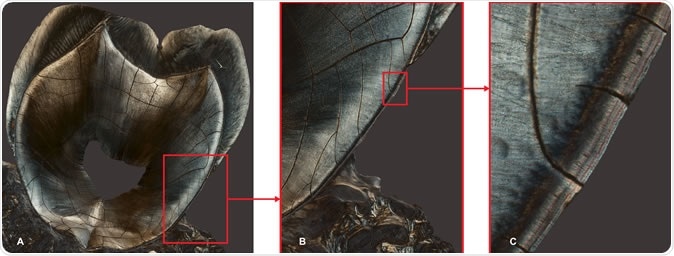Teeth can do more than just masticate. A new study has found that the teeth serve as one's archive in life, recording biological events, from tooth formation to death.
A team of researchers at New York University revealed that the material that makes up tooth roots preserves a lifelong record of stresses to the body, including illness, childbirth, menopause, and even prison time.
Published in the journal Scientific Reports, the study highlights that the substance covering the roots called cementum, which can record subtle, observable growth lines tied to physiological stressors that impact normal tissue formation.
"Our results make clear that the skeleton is not a static organ, but rather a dynamic one," Paola Cerrito, a doctoral candidate in NYU's Department of Anthropology and College of Dentistry and study author, said.

Panel A is a longitudinal section of the maxillary second molar of a 35-year-old female who had children at ages 19 and 24. Panel B is a zoomed-in section of Panel A. Panel C reveals, at left, the dentine, covered, at right, by the cementum, which presents two distinct darker "rings" that correspond to the two reproductive events. Image courtesy of Paola Cerrito
Biological archive
The cementum is the avascular bone-line tissue forming a thin surface layer covering the tooth roots. The substance is structurally unique within the body since it does not undergo remodeling. The cementum works by providing the attachment of the tooth to the alveolar bone and preventing root resorption.
In the study, the researchers discovered that telltale signs of stressful life events are recorded in the teeth, leaving a mark on the cementum. The phenomenon is akin to the way the thickness of annual tree rings can show how the environment and climate affected the tree.
"We didn't know that a portion of our organism served as such faithful biological archive for the entirety of life," Cerrito said.
The study focused on cementum, which forms annual layers, from the time the tooth erupts in the mouth. The tissue, which has not been studied extensively, may pave the way for more debates and studies on its purpose and how it records lifetime events.
"The cementum's microstructure, visible only through microscopic examination, can reveal the underlying organization of the fibers and particles that make up the material of this part of the tooth," Cerrito added.
The study findings
The researchers examined 47 human teeth from 15 people between the ages of 25 and 69. They got the samples from a collection with a known medical history and lifestyle information, including movement from urban to rural areas, age, and illnesses. Further, the researchers also had information on when these events happened.
To examine the teeth samples, they used a wide range of imaging techniques to study the rings of cementum in the teeth roots, identifying what ages different rings correspond to. They found that the different-colored rings appeared to correspond to the ages that people underwent significant life and biological events.
"A tooth is not a static and dead portion of the skeleton. It continuously adjusts and responds to physiological processes," Cerrito explained.
"Just like tree rings, we can look at 'tooth rings': continuously growing layers of tissue on the dental root surface. These rings are a faithful archive of an individual's physiological experiences and stressors from pregnancies and illnesses to incarcerations and menopause that all leave a distinctive permanent mark," he added.
The researchers concluded that other stressful events like systemic illnesses and incarceration could also be detected in the cementum. The team was also able to time all such incidents with high accuracy.
For now, there are still many questions about the purpose of cementum and how it records stressful events in life. This could spark a new focus on major researchers today since the tissue was seldom studied. It can significantly impact future research, spanning from medicine to archeology.
"Furthermore, our results support the growing body of knowledge showing that mineralized tissues have a fundamental role participating in organismal physiology, endocrinology and mineral homeostasis," the researchers concluded in the study.
Journal reference:
Cerrito, P, Bailey, S., Hu, B., and Bromage, T. (2020). Parturitions, menopause and other physiological stressors are recorded in dental cementum microstructure. Scientific Reports. https://www.nature.com/articles/s41598-020-62177-7